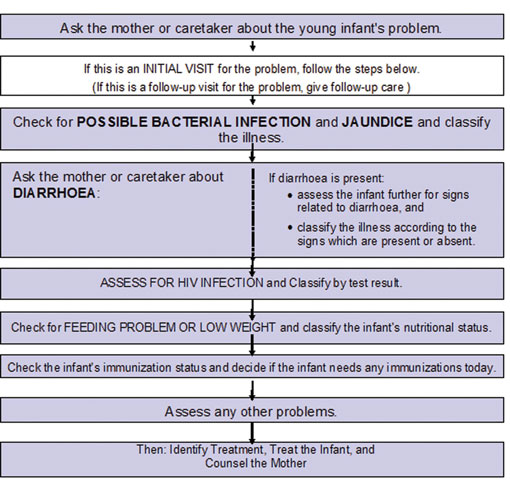15.3.2 Assess and classify the sick young infant
This section describes the steps you should take to assess and classify a sick young infant at the initial visit.
When a sick child is brought to your health post for an initial visit you should always do the following:
- Check for signs of possible bacterial infection. Then classify the young infant based on the clinical signs found
- Ask about diarrhoea. If the infant has diarrhoea, assess for related signs. Classify the young infant for dehydration. Also classify for persistent diarrhoea and dysentery, if present
- Check for feeding problems or low weight. This may include assessing breastfeeding. Then classify feeding
- Check the young infant’s immunization status
- Assess any other problems.
If you find a reason that a young infant needs urgent referral, you should continue the assessment. However, you should not carry out the breastfeeding assessment because this can take some time. Figure 15.4 below summarises these steps.
How to classify possible bacterial infection
Assessing for bacterial infection is critically important and must be done for every sick young infant. In this step you are particularly looking for signs of a serious infection. A young infant can become sick and die very quickly from serious bacterial infections such as pneumonia, sepsis and meningitis.
You should assess and classify all sick young infants for bacterial infection and jaundice. Compare the infant’s signs with the signs listed on the appropriate chart and choose the appropriate classification.
- If the infant has any sign in the top (pink) row, select possible serious bacterial infection or very severe disease.
- If the infant has any sign in the middle (yellow) row, select local bacterial infection.
- An infant who has none of the signs gets the classification of bacterial infection unlikely (green row).
How to assess and classify a young infant for diarrhoea
Remember that you should always ask the mother whether the young infant has diarrhoea. If she says yes, or you see that the young infant has diarrhoea, you should classify for diarrhoea. You learned about this in Study Session 5 of this Module, and should be able to recall that a young infant with diarrhoea is assessed for:
- how long the child has had diarrhoea
- blood in the stool to determine if the young infant has dysentery, and
- signs of dehydration.
Classify diarrhoea
Diarrhoea in a young infant is classified in the same way as it is in an older infant or young child.
Assess for HIV infection
Look at the chart on assessing and classifying the sick young infant for HIV infection. You should ask the mother whether she or her child has had a positive HIV test. Remember this can be a very sensitive issue for the mother so you should ask her in a respectful way and reassure her that the information is confidential.
If the child has had an HIV test, determine whether the test was a rapid test for HIV antibodies, or a DNA PCR test for the virus, and then classify the sick young infant for HIV infection base on the test result.
How to check a young infant for feeding problems or low weight
Assessing feeding and/or low weight problems has two steps. If you look at page 8 in your chart booklet you will see there are two sections in the box separated by a dashed line. In the first (upper) part are the questions you should ask the mother. You need to determine if she is having difficulty feeding the infant, what the young infant is fed and how often. You also need to determine weight for age.
If the infant has any problems with breastfeeding or is low weight for age, you assess how the infant breastfeeds. You will see this is the second (lower) part of the box on page 8 in your chart booklet.
How to classify feeding problems or low weight
There are three possible classifications for feeding problems or low weight:
- Not able to feed — possible serious bacterial infection
- Feeding problem or low weight
- No feeding problem.
How to check the young infant’s immunization status
You should check the immunization status by checking the immunization card, and if this is not available you should ask the mother what vaccinations her child has received
How to assess other problems
Assess any other problems mentioned by the mother or observed by you.
You are now going to look at how to assess and classify children aged between two months and five years.
15.3.1 Steps of immediate newborn care

